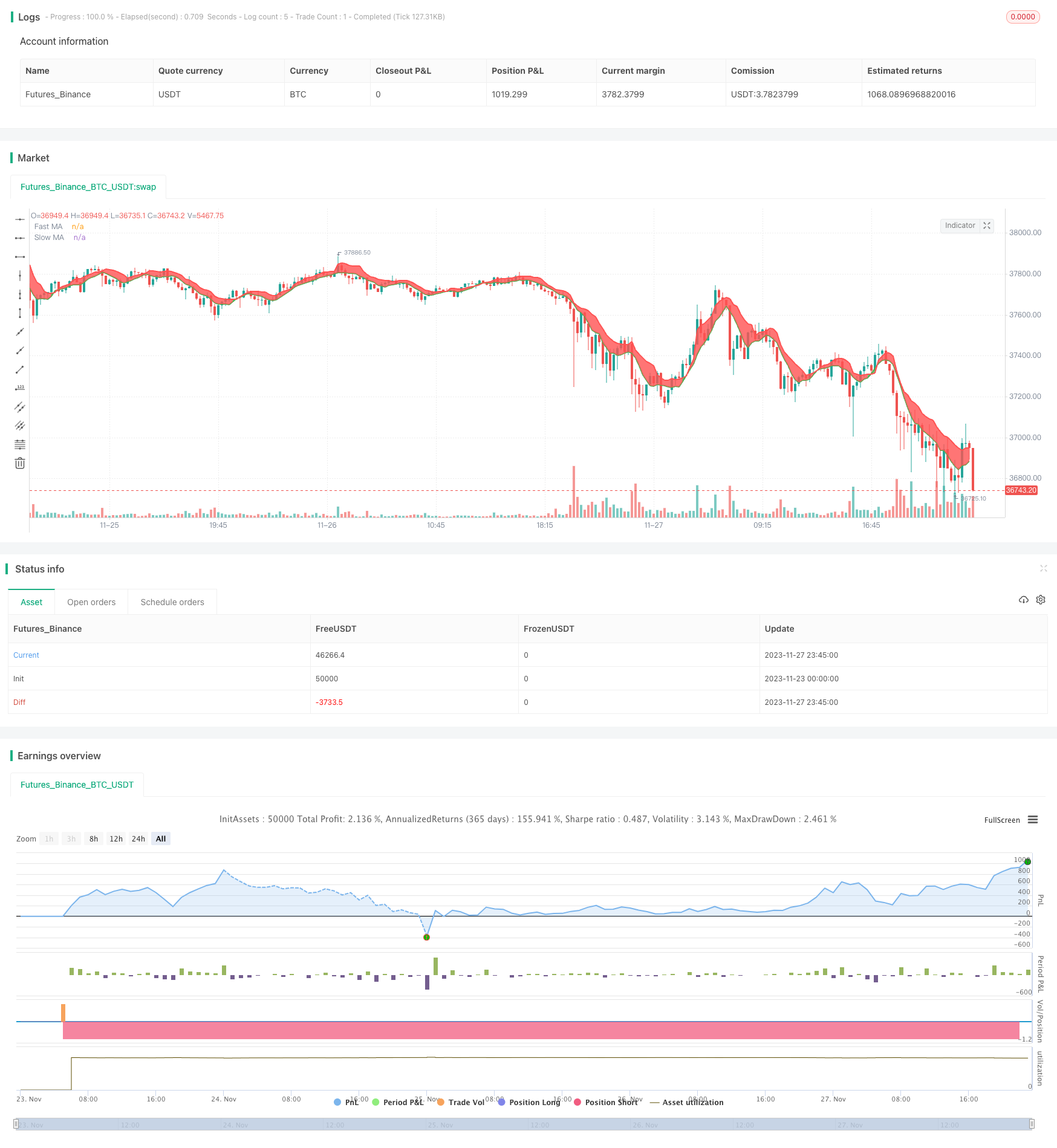
개요
이 전략은 쌍평균선 교차에 기반한 트렌드 추적 전략이다. 그것은 빠른 간단한 이동 평균 ((SMA) 과 느린 중화 이동 평균 ((VWMA) 을 결합하여 두 평균선의 교차를 이용하여 구매 및 판매 신호를 형성한다.
빠른 SMA가 느린 VWMA를 상향으로 통과하면 구매 신호가 발생하고, 빠른 SMA가 느린 VWMA를 상향으로 통과하면 판매 신호가 발생한다.
전략 원칙
이 전략의 핵심 논리는 이중 평행선 교차 시스템을 기반으로 합니다. 구체적으로, 다음과 같은 기술 지표를 동시에 사용합니다:
- 간단한 이동 평균 ((SMA): 최근 n일간의 종결 가격의 수학적 평균을 취하여 최근 기간의 평균 가격을 반영한다.
- 가중 이동 평균 ((VWMA): 최근 n일 종결 가격에 가중된 평균을 사용하여, 최근 가격에 더 큰 무게를 부여하여 가격 변화에 더 빠르게 반응할 수 있다.
이중 평균선에서의 빠른 SMA 파라미터 설정이 짧아서 가격 변화에 빠르게 반응할 수 있습니다. 느린 VWMA 파라미터이 길어서 파동 작용을 합니다. 단기 및 장기 트렌드가 같은 방향으로 진행될 때, 빠른 SMA는 느린 VWMA를 상향으로 통과하면 구매 신호를 생성합니다. 아래로 통과하면 판매 신호를 생성합니다.
이 전략은 동시에 손해 제도를 설정한다. 가격이 불리한 방향으로 움직일 때, 위험을 통제하기 위해 제 시간에 손해를 막는다.
우위 분석
- 빠르게 반응하고, 시장 추세 변화에 따라
- 회수 통제, 위험 통제
- 간단하고 직관적이고 이해하기 쉬운 구현
- 다른 시장 환경에 적응하여 파라미터를 조정하여 최적화 할 수 있습니다.
위험 분석
- 이중평균형 전략은 다중 시장의 잘못된 신호를 유발할 수 있습니다.
- 적절한 매개 변수를 선택해야 합니다. 잘못 설정하면 손실이 발생할 수 있습니다.
- 가끔은 Markt의 갑작스러운 사건으로 인해 머리가 아프기도 합니다.
위험 관리 방법:
- 트렌드 필터링을 사용하여 확인
- 최적화 변수 설정
- 단독 손실을 적절하게 통제하기 위한 손실 차단 전략
최적화 방향
이 전략은 다음과 같은 부분에서 최적화될 수 있습니다.
- 다른 기술 지표와 함께 확인, 예를 들어 RSI, 브린 라인 등, 신호의 정확성을 향상
- 평균선 변수의 길이를 최적화하여 다른 주기에 따라 변수를 조정합니다.
- 거래량 지표와 결합하여 많은 에너지의 입출력 지점에서 거래
- 역 측정 결과에 따라 파라미터를 조정하고 최적의 파라미터를 선택합니다.
- 동적 스톱을 사용하여 시장의 변동에 따라 스톱 포인트를 조정합니다.
요약하다
이 전략은 전체적으로 매우 실용적인 트렌드 추적 전략이다. 그것은 간단한 직관적 이중 평균선 교차를 사용하여 거래 신호를 생성하고, 빠른 평균선과 느린 평균선의 조합을 통해 시장 추세의 변화를 효과적으로 포착할 수 있다.
전략 소스 코드
/*backtest
start: 2023-11-23 00:00:00
end: 2023-11-28 00:00:00
period: 15m
basePeriod: 5m
exchanges: [{"eid":"Futures_Binance","currency":"BTC_USDT"}]
*/
//@version=4
//strategy(title="Bitlinc Entry v0.1 VWMA / SMA / MRSI SQQQ 94M", overlay=true, initial_capital=10000, currency='USD')
strategy(title="Bitlinc Entry v0.1 VWMA / SMA / MRSI SQQQ 94M", overlay=true)
// Credit goes to this developer for the "Date Range Code"
// https://www.tradingview.com/script/62hUcP6O-How-To-Set-Backtest-Date-Range/
// === GENERAL INPUTS ===
// short ma
maFastSource = input(defval = close, title = "Simple MA Source")
maFastLength = input(defval = 6, title = "Simple MA Length", minval = 1)
// long ma
maSlowSource = input(defval = high, title = "VW MA Source")
maSlowLength = input(defval = 7, title = "VW MA Period", minval = 1)
// === SERIES SETUP ===
// a couple of ma's...
maFast = sma(maFastSource, maFastLength)
maSlow = vwma(maSlowSource, maSlowLength)
// === PLOTTING ===
fast = plot(maFast, title = "Fast MA", color = color.green, linewidth = 2, style = plot.style_line, transp = 30)
slow = plot(maSlow, title = "Slow MA", color = color.red, linewidth = 2, style = plot.style_line, transp = 30)
// === INPUT BACKTEST RANGE ===
FromMonth = input(defval = 1, title = "From Month", minval = 1, maxval = 12)
FromDay = input(defval = 1, title = "From Day", minval = 1, maxval = 31)
FromYear = input(defval = 2018, title = "From Year", minval = 2017)
ToMonth = input(defval = 1, title = "To Month", minval = 1, maxval = 12)
ToDay = input(defval = 1, title = "To Day", minval = 1, maxval = 31)
ToYear = input(defval = 9999, title = "To Year", minval = 2017)
// === FUNCTION EXAMPLE ===
start = timestamp(FromYear, FromMonth, FromDay, 00, 00) // backtest start window
finish = timestamp(ToYear, ToMonth, ToDay, 23, 59) // backtest finish window
window() => time >= start and time <= finish ? true : false // create function "within window of time"
// === LOGIC ===
enterLong = crossover(maFast, maSlow)
exitLong = crossover(maSlow, maFast)
//enterLong = crossover(maSlow, maFast)
//exitLong = crossover(maFast, maSlow)
// Entry //
strategy.entry(id="Long Entry", long=true, when=window() and enterLong)
strategy.entry(id="Short Entry", long=false, when=window() and exitLong)
// === FILL ====
fill(fast, slow, color = maFast > maSlow ? color.green : color.red)
// === MRSI ===
//
//
basis = rsi(close, input(50))
ma1 = ema(basis, input(2))
ma2 = ema(basis, input(27))
oversold = input(32.6)
overbought = input(63)
//plot(ma1, title="RSI EMA1", color=blue)
//plot(ma2, title="RSI EMA2", color=yellow)
obhist = ma1 >= overbought ? ma1 : overbought
oshist = ma1 <= oversold ? ma1 : oversold
//plot(obhist, title="Overbought Highligth", style=columns, color=color.maroon, histbase=overbought)
//plot(oshist, title="Oversold Highligth", style=columns, color=color.yellow, histbase=oversold)
//i1 = hline(oversold, title="Oversold Level", color=white)
//i2 = hline(overbought, title="Overbought Level", color=white)
//fill(i1, i2, color=olive, transp=100)
// === LOGIC ===
enterLongMrsi = crossover(ma1, oversold)
exitLongMrsi = crossover(ma1, overbought)
// Entry //
strategy.entry(id="MRSI Long Entry", long=true, when=window() and enterLongMrsi)
strategy.entry(id="MRSI Short Entry", long=false, when=window() and exitLongMrsi)
//hline(50, title="50 Level", color=white)